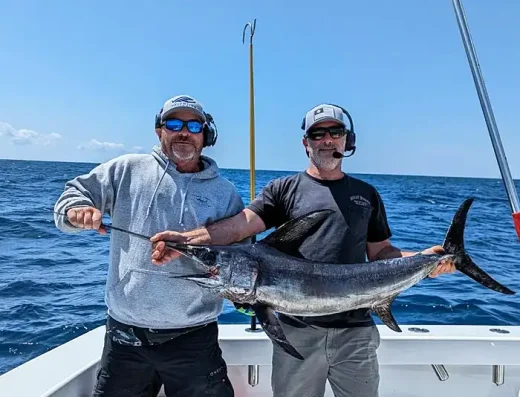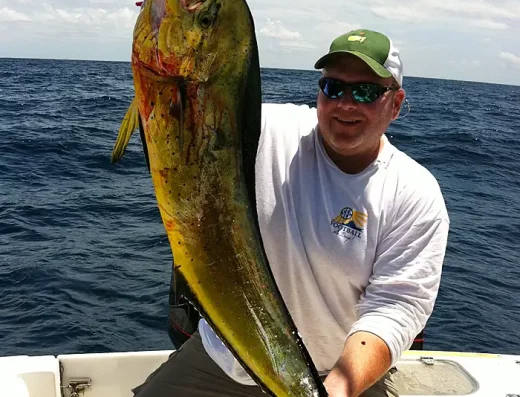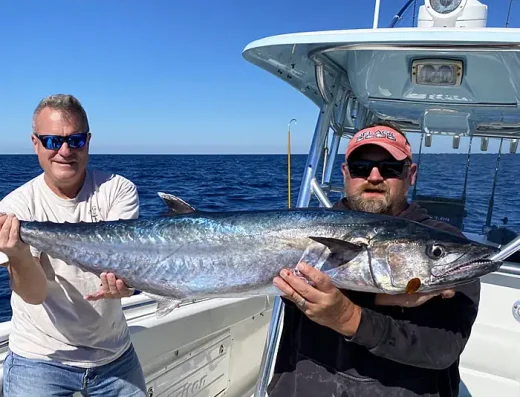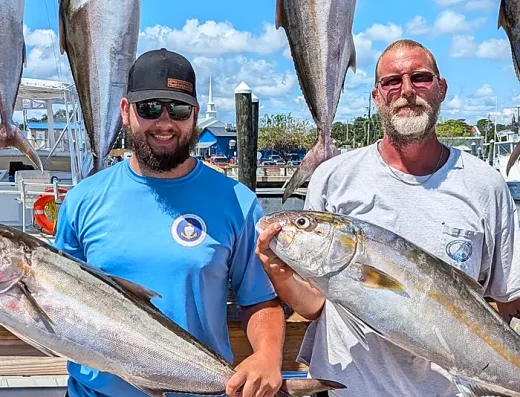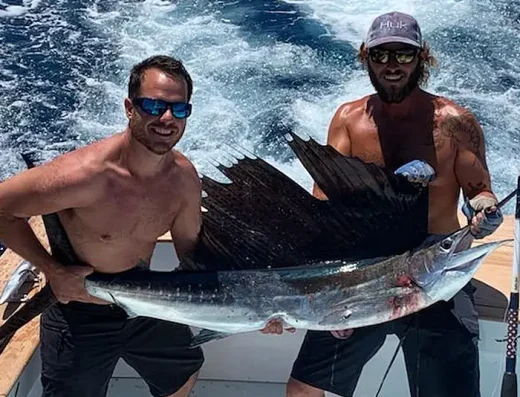North Carolina Fishing Charters
North Carolina fishing charters cover everything from backcountry drum runs in the Pamlico Sound to bluewater billfish hunts off the Outer Banks.
TrustedFish connects anglers with proven local captains in North Carolina —no commissions, no pay-to-play listings, no BS. Every charter on our platform is invite-only, vetted for skill, local knowledge, and reputation. If they’re listed, they’ve earned it.
Top Rated Charters in North Carolina
Click to View Destinations
North Carolina Fishing Guide
North Carolina has some of the most versatile fishing on the East Coast. You’ve got shallow inshore waters stretching through the Albemarle and Pamlico Sounds, tidal creeks loaded with flounder and drum, barrier islands with quick access to king mackerel and cobia, and a steep offshore drop that puts marlin within striking distance. The Outer Banks especially—places like Hatteras and Oregon Inlet—offer direct runs to the Gulf Stream, where boats troll for mahi, wahoo, sailfish, and tuna.
Most saltwater charters here run out of coastal towns like Morehead City, Wrightsville Beach, Topsail, and down into the Cape Fear region. Half-day inshore trips work the marshes and jetties with popping corks, live shrimp, or Gulp on jigheads. Full-day offshore trips push 30–50 miles, rigged with ballyhoo and skirted lures depending on what’s running. In the summer, kings and Spanish move closer in, giving nearshore captains plenty to work with.
Freshwater? There’s no shortage. You’ve got Lake Norman and Lake Wylie for stripers and bass. Kerr Lake (Buggs Island) and Lake Gaston on the Virginia line are full of catfish and crappie. Up in the mountains, the rivers get cold enough for stocked and wild trout. Guides wade or float drift boats on the Watauga, Tuckasegee, and Nantahala, throwing nymphs and dries when the timing’s right.
North Carolina gives you year-round options—whether you’re soaking cut bait for reds in a winter creek, skipping soft plastics under docks for summer bass, or running the break for yellowfin tuna in spring. Most towns have boat ramps or marinas close to town, and bait shops know what’s hitting that week. No need to overthink it—just match the water and the season, and you’ll find fish.
Regional Fishing Highlights
Outer Banks
The Outer Banks are famous for their deep sea game. Oregon Inlet and Hatteras boats have direct access to the Gulf Stream—big plus. That’s where the yellowfin, blackfin, mahi, and marlin bite when conditions line up. Inshore, you’ve got shallow sounds and sloughs full of speckled trout, drum, and flounder. Summer brings in cobia along the beaches. Trolling, jigging, and popping corks all get used here, depending on the target.
Crystal Coast (Morehead City, Atlantic Beach)
This stretch is kingfish central in summer. Spanish mackerel swarm nearshore, and cobia roll through the bait pods just off the beaches. The Cape Lookout shoals hold drum and flounder, and the backwaters are solid year-round. Offshore runs out of Morehead reach the Gulf Stream for mahi, tuna, and wahoo. It’s a mixed-bag zone where you can load up quick on a good tide swing.
Cape Fear & Wilmington
Down south, the Cape Fear River spills out into a marshy delta where reds and trout hold tight in the grass lines. Charter boats hit nearshore wrecks for sea bass and kings, while full-day runs chase tuna and mahi when they push in. Wrightsville Beach and Carolina Beach both offer easy access to a mix of inshore and offshore grounds. Good options for families or serious offshore guys.
Western NC Lakes & Rivers
The mountains are trout country—float trips on the Nantahala, Tuckasegee, or Watauga give fly anglers a shot at browns, rainbows, and brookies. Summer brings bass and walleye action on Fontana and Lake James. Lake Norman and Jordan Lake in the piedmont are full of largemouth and spotted bass, with night fishing picking up when the heat kicks in.
Fishing Seasons in North Carolina
Spring
Red drum and speckled trout start to stir inshore once the water warms past 55°. Flounder trickle in by May. Cobia migrate up the coast, especially off Hatteras and Morehead. Offshore, yellowfin tuna bite hard March–May. Inland, bass come shallow to spawn, and mountain trout streams stay cold and productive.
Summer
Spanish mackerel, kings, and flounder are thick nearshore. Drum school in the sounds and rivers. Offshore crews chase mahi, billfish, and wahoo. Lakes warm up—bass go deeper mid-day, but you can pick up stripers early and late. Night catfishing is solid statewide.
Fall
Best drum action of the year, especially in the Pamlico and Neuse rivers. Trout bite turns on hard. Offshore, wahoo get thick, and king mackerel stack up around structure. In freshwater, bass chase bait to the backs of creeks and trout feed heavy before winter.
Winter
Inshore slows but doesn’t shut down—trout and redfish hold deep in creeks and docks. Offshore trips target blackfin tuna and scattered wahoo. Stripers push into the rivers like the Roanoke. Mountain trout still hit nymphs and small streamers if the water doesn’t freeze.
Most Popular Gamefish in North Carolina
- Red Drum – 18–40 inches. Marshes, sounds, and creeks spring through fall. Cut bait, popping corks, or sight casting.
- Speckled Trout – 14–24 inches. Inshore rivers and creeks fall through early spring. Shrimp under corks, paddle tails, MirrOlures.
- Flounder – 12–25 inches. Edges, docks, and inlets in summer. Gulp on jigs or finger mullet on Carolina rigs.
- Cobia – 25–60 pounds. Migrates up coast in spring/summer. Sight-cast bucktails or live bait near buoys and bait pods.
- King Mackerel – 10–40 pounds. Nearshore/offshore summer and fall. Slow troll live menhaden or dead cigar minnows.
- Yellowfin Tuna – 30–90 pounds. Spring offshore near Gulf Stream. Trolled ballyhoo or chunked butterfish.
- Wahoo – 20–80 pounds. Fall and winter offshore. High-speed troll with dark skirted lures.
- Largemouth Bass – 1–7 pounds. Piedmont lakes year-round. Crankbaits, jigs, and soft plastics around docks and brush.
- Rainbow Trout – 10–20 inches. Mountain streams and tailwaters. Nymphs, dries, or spinners in cold water.
North Carolina Fishing FAQs
Do I need a fishing license in North Carolina?
Yes—non-residents and residents need either a coastal or inland license, depending on where you’re fishing. Charter trips usually include it, but always ask.
What’s the best time of year for offshore fishing in North Carolina?
April through June is prime for yellowfin tuna and mahi. Fall is strong for wahoo and kings. Weather windows matter more than exact dates.
Can I keep redfish in North Carolina?
Yes, one per person between 18–27 inches, but check current slot and season rules—they can change.
Where can I fish for trout in North Carolina?
Head west—rivers like the Tuckasegee, Nantahala, and Watauga are good bets. Some are hatchery sWhat kind of bait works best inshore?upported, others are wild or catch-and-release only.
What kind of bait works best inshore?
Live shrimp, mud minnows, and finger mullet are solid. Gulp or soft plastics on jigheads work when live bait isn’t an option.
Are fishing charters kid-friendly in Wilmington?
Many are—especially half-day inshore trips targeting trout, drum, and flounder. Just let the captain know ahead of time.
How far offshore do tuna trips go?
Most run 30 to 60 miles, depending on season and where the Gulf Stream edges sit that week.
Is night fishing worth it on NC lakes?
Depends on the trip—nearshore boats may stay within 5 miles. Full-day offshore trips run 20 to 50 miles, depending on weather and target species.
What should I bring on a North Carolina fishing charter?
Sunblock, hat, deck shoes, and layers. Most boats provide gear and tackle, but call ahead just in case.

